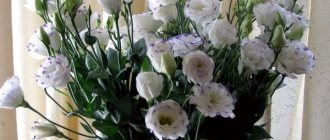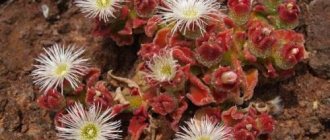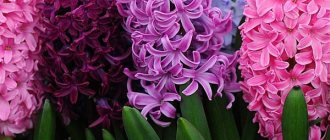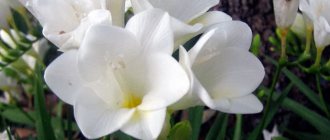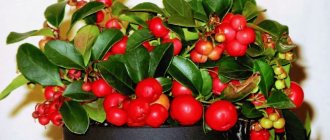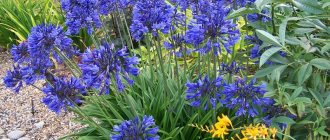Many gardeners prefer to grow proven and unpretentious flowers, but sometimes the soul craves the exotic. If this is your case, plant ranunculus - the plant, although it will require time and care, will generously reward you with unforgettable flowering. When you first see the bright double buds, reminiscent of unblown peonies or small roses, it is difficult to imagine that this is a garden variety of buttercup.
Exquisite and delicate heads of garden buttercups
Origin
Ranunculus (lat. Ranunculus) , or Asian buttercup (garden) is a herbaceous perennial plant of the buttercup family that came to us from Asia Minor. Its name means “frog” in Latin, and this is not without reason. In the wild, many buttercups prefer flooded areas and high air humidity, along with good ventilation and sufficient warmth.
Having arrived in England in the 16th century, this flower quickly gained popularity among flower growers, but retained its position only until the end of the 19th century. After a long break, Ranunculus again ascended to the flower pedestal. The hard work of breeders has contributed to the emergence of more than 600 varieties of Ranunculus.
Wild species of ranunculus
In addition to ornamental varieties, ranunculus has many wild varieties , many of which have medicinal properties. Wild varieties can be found everywhere - from meadows, valleys and fields, to forests, floodplains and mountainous areas. Natural specimens, as a rule, begin to bloom earlier than garden buttercups.
Only people who prefer to be outdoors on weekends can see wild varieties. Some avid gardeners grow wild buttercups in their flower beds , creating alpine slides, rockeries and other landscape decorations.
Let's look at a few of the most popular:
Acrid buttercup (Ranunculus acris) . The plant is 20-50 centimeters high with yellow flowers reaching 2 centimeters in diameter. Dangerous for mucous membranes. Causes irritation upon contact.
Multi-flowered buttercup (Ranunculus polyanthemos) . The species is widespread in Ukrainian forests. May be found in dry meadows or grassy slopes. Has bright yellow inflorescences. Flowering time is from June to August.
Creeping buttercup (Ranunculus repens). It belongs to poisonous plants, but still this does not prevent gardeners from using plants like bindweed when decorating flower beds. It is used as a ground cover to fill empty areas. Another variety is the poisonous buttercup (Ranunculus sceleratus)
Water (marsh) buttercup (Ranunculus aquatilis). The main habitat is swamps and flooded meadows. Water buttercup (inundatus) - Ranunculus inundatus, belongs to the same category of plants.
Buttercup aconitifolius . A tall plant reaching 1 meter in height. Includes white and gold colors with terry shapes.
Alpine buttercup (alpestris) - includes annual and perennial varieties. The Russian flower grows in the forests of Western and Eastern Siberia.
Buttercup glacial or Bekvicia glacial. Full name: Ranunculus glacialis. The main places where wild varieties grow are rocky areas, cliffs and the banks of mountain rivers.
Japanese buttercup (japonicas). Unfortunately, it is practically unknown in Russia.
Spring clearweed - Ficaria Verna (formerly Ranunculus Ficaria L.). If you want to purchase this variety in the store, you need to look for it under the name “Spring buttercup collarette.” This name is typical for Western flower growers. In our regions it is called Chistyak. The leaves are dark green in color with deep veins. The shape of the flowers resembles small yellow anemones. Flowering time is May. A synonym for the name, often used among the people, is common chickweed (Buttercup ficaria).
Spring buttercup - Brazen Hussy - perennial - wild plant, not exceeding 10 centimeters in height. Flowering begins after the snow melts. It has bright yellow flowers. When grown in gardens, it prefers partial shade with soil of moderate humidity.
Attention! When growing wild varieties in your flowerbed, you need to be extremely careful, since many buttercups growing in the wild are classified as poisonous and if you come into contact with them, there is a risk of harm to health.
Description
The description of the marvelous flowering of the Ranunculus flower is worthy of an artist’s brush. One glance is enough to fall in love with him once and for all. Outwardly, it looks like an unusual rose or an unopened peony bud, and to some it slightly resembles a terry water lily.
According to botanical descriptions, Ranunculus has the following characteristics:
- reaches a height of 20-80 cm, depending on the height of the stem, it is divided into low-growing (up to 25 cm) and tall (up to 40 cm);
- stems are powerful, succulent;
- leaves are dissected;
- tuberous rhizome;
- the flower is formed from a large number of petals tightly adjacent to each other, has a diameter of 5 to 10 cm;
- inflorescences are 6 double, semi-double and densely double;
- the color palette is varied, including white, yellow, pink and all shades of red and burgundy (with the exception of blue and cyan tones).
- perennial plant;
- not frost-resistant;
- Suitable for growing at home.
Old and modern varieties
The selection of ranunculus goes back several centuries; hundreds of varieties have been bred with various colors, petal shapes, and degrees of terry. In Europe, it is very popular as a container crop and decorates windows, balconies, open verandas, and gazebos everywhere. This plant is rare in our gardens, as can be seen even from the names of the varieties sold. Basically there is a name (garden buttercup or ranunculus) and a color designation (yellow, pink).
Let's try to understand the assortment in more detail. All garden flower forms are usually combined into 4 groups.
- The Persian variety is the oldest and includes tall varieties intended for cutting. The flowers are large, double or semi-double, bloom in spring.
- Turkish or turban-shaped buttercups are distinguished by petals twisted inside the flower; they are also called peony-shaped.
- French ranunculus is less double than other forms, the color ranges from white to purple, and blooms in summer.
- The Asian group is the most extensive and, through the efforts of breeders, continues to grow. The peculiarity of varieties and hybrids of the Asian species is that they are low-growing bushy plants that are quite resistant to heat and bloom throughout the summer.
Let us give examples of the most popular varieties and hybrids of crops that grow quite productively in our climatic conditions.
- Bloomingdale's, our tubers are sold as Blooming Valley - a large group of hybrid ranunculi that come in one color (white, red, yellow, pink, orange) or as a mix of colors.
- Color Carnival is a beautiful variety with tall stems up to 70 cm, perfect for cutting. Flowers of warm colors create a bright sunny island in the garden, over which butterflies and insects constantly circle.
- Superbissima is a tall variety, predominantly with white and red semi-double flower heads.
Varieties for a bouquet
Advice! It has been noticed that ranunculus, when propagated by tubers, loses its decorative qualities after a few years. This applies to modern hybrids, which are better to buy annually, but you can breed old proven varieties yourself.
Ranunculus in home cultivation
Ranunculus can decorate any window sill and will become a real highlight of the flower collection. However, growing such an outlandish flower will require a lot of knowledge and skills.
Asian Buttercup (Ranunculus) is a capricious and demanding plant. Growing it is difficult and troublesome; a novice florist may not be able to cope with it. Ranunculus will thank those who are not afraid of difficulties with outlandish bright flowers
First of all, you need to decide what you want to grow Ranunculus from. It can be grown from seeds or from tubers. Each technique has a specific cultivation pattern.
We also recommend: Globular chrysanthemum: cultivation and care rules
Planting buttercups with tubers
We made a general description of the buttercup family, examined the main types and features of growing plants from seeds. However, this method is used infrequently. A more common method of growing garden buttercups is by planting roots. They are sold in flower departments, but can be obtained independently by digging up tubers and dividing the root system.
Buttercup tubers
Planting material is chosen, paying attention to even minor details. Traces of pests and mold, and other defects indicate that they are trying to sell you roots of dubious quality. The germination rate will be low.
- Since planting material is offered in dried form, it must be well prepared before planting. For example, immersing it in a weak solution of potassium permanganate for 40 minutes is a good disease prevention.
- Then each root is wrapped in wet gauze and left for a couple of hours. The procedure is repeated again, but the roots are wrapped in cloth or gauze and placed in a bag and placed in a cool place overnight.
- After such simple manipulations, the roots swell well and become like octopuses. In this form, garden buttercups are completely ready for planting and care.
Growing Ranunculus at home from seeds
The seed method is less expensive, but longer. Seeds need to be purchased in stock and in various shades. Thus, in one flower pot it will be possible to grow a whole mini-club on the window.
One bag contains no more than 11-12 seeds. Ranunculus seeds do not have 100% germination, this also needs to be taken into account. Choose low-growing hybrids, they are the ones that will grow better in the house
Once the seeds have been purchased, you can start planting them. To do this you will need: a spacious container with drainage holes (a balcony flower box is suitable), soil, a spray bottle, film or glass, and of course a great desire. Sowing seeds for seedlings is carried out in the second half of February.
Step-by-step planting with seeds:
- Prepare a planting container.
- Before planting, sort the seeds for defects, and wrap healthy seeds in gauze and soak in warm water for 2-3 hours.
- Moisten the planting soil.
- Plant seeds to a depth of 1 -1.3 cm. The distance between seeds is 1-2 cm.
- Do not water after planting.
- Cover the container with a bag or glass. Create a greenhouse effect.
- Seed germination temperature +18 C.
- The location is as sunny as possible.
- Ventilate the crops daily. Spray from a spray bottle.
After 2.5-3 weeks, the seeds will hatch and show their first “spouts”. When 3-4 young leaves appear on the flower, the seedlings are picked and transplanted into separate containers. It is best to take peat pots for this purpose. Be prepared for the fact that out of 12 seeds only 3-4 will sprout. It is possible that you did something wrong, or the seeds were stored in inappropriate conditions.
When the plants grow stronger and gain strength, they can be planted for permanent residence in a flower pot. Up to 5 roots are planted in one pot. This is the only way to achieve the shape of a bouquet. Therefore, you need to take care of a suitable flowerpot in advance. Do not choose flowerpots that are too bright and elegant. They may not be combined with the blooming “Asian buttercup” in the future.
When growing Ranunculus from seeds in the first year of life, the plants form only a tuberous system. Flowering in this case occurs only at 2-3 years of life.
Ranunculus care
Ranunculus is unpretentious, so the specifics of caring for it are very simple. Monitor the humidity, avoid frost and be sure to immediately select a permanent place, because the flower does not tolerate transplantation.
Temperature
Ranunculus loves warmth. For germination, it prefers a temperature of about +17 degrees, for life - up to +25. Tubers can be stored and transported at a temperature of about +7 degrees.
Photo: eva.ru
Lighting
With all the riot of colors, ranunculus prefers partial shade. It is in this area that the plant grows fastest and blooms most profusely. And be sure to avoid drafts and cold winds.
Photo: zen.yandex.ru
Watering
Ranunculus tubers have a high tendency to rot, so you should absolutely not overwater them. Watering should be regular, and in hot weather - up to several times a week. But very moderate, and only in loosened soil.
Photo: ru.wallpaper.mob.org
The soil
Choose nutritious fertile soil, preferably with neutral acidity. Loams work well, but add some compost and sand before planting. And they loosened the soil well so that water did not stagnate in it.
Photo: liveinternet.ru
Fertilizers and fertilizing
When planting, add a little potassium fertilizer to the soil so that the ranunculus begin to form buds earlier and more abundantly. In the future, you can simply use complex mixtures for flowering garden plants once every 2-3 weeks.
Photo: mykaleidoscope.ru
Trimming
Ranunculus does not need to be shaped or trimmed for beauty, because it grows neatly on its own. But it is important to quickly remove faded buds and the flower stalks themselves. You can safely cut them off at the root.
Photo: goodfon.ru
Wintering
Ranunculus will not survive even slight frosts in open ground, so after flowering the tubers are dug up. Each one needs to be carefully cleaned, briefly soaked in potassium permanganate, dried and placed in paper bags. They can be stored in cool rooms and even in the refrigerator, but the main thing is that the temperature does not rise above +15 degrees.
Photo: mykaleidoscope.ru
Dracaena (70 photos): types and features of care
Growing Ranunculus at home from tubers
It is easier and faster to grow ranunculus from tubers than from seeds. They are not too expensive, and the effect is much better. In order for the tubers to take root better and grow faster, you will need to study a number of recommendations.
Step-by-step planting with tubers
- Before planting, soak the tubers for 5-10 hours. To activate growth, you can use Epin or Kornevin solution as an aid.
- You can place 5-7 ranunculus tubers in one pot, at a distance of 10 cm from each other.
- They need to be planted with the nodules down. Visually, the tubers look like a type of dahlia, only very small, similar to spiders.
- Don't bury it. Sprinkle with soil so that the top of the tuber can breathe air.
- For germination, place in a bright place, the growing temperature is not higher than +12C for the first time. When the sprouts reach 3 cm, the growing temperature rises to +22 C.
- Moisten the soil with a spray bottle daily, do not allow it to dry out.
We also recommend: Gladioli: basic rules for care, storage and planting
If all planting and maintenance conditions are met, thanks to the tuberous method, you can expect triumphant flowering of Ranunculus within 2-3 months.
Outdoor care
Already after 2-3 months after planting the tubers, there is a chance to see the first flower stalks. Ranunculus begins to bloom fully in mid-summer - June-July.
According to statistics, the survival rate of plants is 7 plants out of 10 . And it is not a fact that out of the 7 survivors, all ranunculi will reach the flowering phase. This deficiency manifests itself as a result of rapid loss of moisture from tubers .
This is also affected by insufficient resistance to unfavorable conditions in the first 2 weeks after planting. Timely and high-quality care is the key to increasing survival rate and the possibility of good flowering.
Watering
Caring for the plant consists of regular watering moderate amounts. Since waterlogging leads to rotting of the tuber, and insufficient watering leads to poor development. The lack of color on a garden buttercup indicates insufficient watering of the plant. As soon as flowering ends, you need to pour 2 times less water.
Feeding and fertilizer
Feeding is carried out 2 times a month . Ranunculus responds well to potassium supplements, which are applied for the first time at the tuber planting stage. Potassium salt and ash are suitable for this .
An excellent addition would be mullein or complex mineral fertilizers . Fertilizers are applied at the rate of 40 grams per 1 square meter. Do not forget about feeding during flowering, since during this period the plant gives off a large amount of energy.
Watering
For its love of groundwater and marshy places, Ranunculus is called a frog, but this does not mean that it can be watered without measure. When watering a flower, you need a golden mean. You need to water frequently, but not too vigorously. There is no clear watering schedule. It depends on how much light hits the flower, what the air temperature is, and how many tubers are in the pot. The reference point is the dryness of the soil. During the period of active growth or flowering, fertilizers can be added to the water for irrigation.
The water for watering the Ranunculus flower is soft, clean, without chlorine impurities. In summer, rainwater is suitable for it, and in winter, melt water. If possible, use spring water, as well as water passed through a carbon filter.
Key Features
The plant is perennial, with an average height of 40 to 50 cm. Buttercup has strong, tuberous roots, so reminiscent of tiny spiders. Beautiful, strongly dissected leaves of green color, with an emerald tint. Each tuber produces 4 peduncles.
On such a peduncle, from 1 to 10 flowers are formed, with different diameters. Flowers bloom all summer, one after another. With double and semi-double petals. Colors: all colors of the rainbow, except blue shades.
Like all tuberous crops, ranunculus lives in cycles from year to year. With the arrival of spring, the first cycle begins: the growing season, from bud break to flowering to seed formation.
The second cycle begins with the withering and death of the entire above-ground part (stem, leaves, flowers) and at the same time the tuber ripens in the underground part. the third cycle includes winter hibernation of the plant; during hibernation, flower buds are laid on the tuber. And then everything repeats again.
Buttercup belongs to ephemeroid plants.
Breeders are developing varieties that have larger flowers and different colors, with a longer flowering period. Varieties are developed that are planted specifically on borders.
Low plants grown in pots look very beautiful on balconies or loggias. Of course, multi-colored buttercups will decorate any garden. Let's see how we can sort through a large assortment.
Ranunculus after flowering
As soon as the plant sheds its last inflorescences, it can be moved to a darker, cooler place, where it will continue to grow for some time. Afterwards, you will notice that the Ranunculus leaves have withered and turned yellow, but do not rush to panic - this is a sign that the plant is entering a dormant phase.
We also recommend: Gladioli: basic rules for care, storage and planting
Move the ranunculus to a room with a temperature of 15-18 °C. The plant will remain dormant for about a month, after which, in April, it will delight you with new shoots. Each rhizome produces an average of 5-7 new shoots.
Growing problems
Experienced flower growers know about some important nuances in caring for a handsome flower. To ensure that your green pet grows beautiful and healthy, the following recommendations will help:
- Doesn't like transplantation. Frequently moving from pot to pot does not have the best effect. But once every three years, changing the container is necessary.
- During flowering, it is important to fertilize. It must contain vermicompost. Otherwise, the plant will die because the root will be burned.
- During the period of replenishment with fertilizer, the pots are removed to a darker place and watering is reduced. Then the flowering will last longer.
- The tubers are very fragile, so all manipulations are carried out as carefully and accurately as possible.
- If the rhizome has grown too much, then it is necessary to separate the “babies” and plant them in pots.
- The roots are prone to rapid dehydration and are susceptible to various misfortunes in the first weeks of development. Therefore, it is important to follow the basic rules of agricultural technology for this plant.
Diseases and pests
| Description of the problem | Cause | Solution |
| Ranunculus does not bloom | Not enough nutrients. Too much watering. The light regime is broken. | Feed with potash fertilizers. Reduce watering. Move to another location. |
| Drops buds | Abundant watering. rotting of the root system. | Reduce watering. Place in the sun and dry. Move to partial shade. |
| The leaves are curling. The plant slows down its growth | Nematode disease. | Dig up the tubers, clean them as much as possible and dip them in water at a temperature of +55C. Replace the soil. |
| Leaves become covered with yellow spots and become sticky | Spider mite | Insecticides Fitoverm and Neoron will help. And also a soap solution: infusion of garlic, onion peels. |
Recommendations and common mistakes
Growing ranunculus using the seedling method is not the most difficult procedure. But novice gardeners often make mistakes that lead to the death of seedlings or their weakening.
When growing buttercups, you must follow several important rules:
- It is imperative to stratify the seed material - if you neglect the procedure, the seedlings will be weak or will not sprout;
- plant seeds of the plant only in nutritious soil with the addition of peat and organic matter - ranunculus does not develop well in poor soil;
- before sowing, disinfect the substrate, container and grains themselves with Fitosporin or a solution of potassium permanganate to protect against viruses and fungi;
- during the growing process, ensure that the ranunculus seedlings receive a sufficient amount of sunlight;
- protect young shoots from cold drafts and sudden temperature changes;
- transfer seedlings to the ground only after the final onset of spring warmth;
- When planting, do not bury the seeds too deeply, otherwise it will be difficult for the sprouts to break through to the surface.
If desired, you can collect seed material on your own plot from adult ranunculi. The buds are wrapped in gauze immediately when they bloom, and after wilting, they are cut off along with the bag. The seeds are shaken out onto white paper, dried and stored.
Advice! Planting ranunculus grains for seedlings is carried out with a reserve, since a certain part of the material will inevitably die and will not sprout.
Ranunculus seeds should be stored at a temperature of 18-22 °C
Summarizing
Ranunculus is a gorgeous flower that even a queen deserves. However, it has a number of features that place it in the category of demanding plants.
- Too demanding to care for, not suitable for beginner gardeners.
- Ranunculus has weak and sensitive roots.
- The plant is sensitive to transplants.
- Flowering occurs only with 100% compliance with the conditions of maintenance.
- Has a long rest period.
- Not long-lived.
- Not frost-resistant.
- Difficult to adapt to environmental conditions.
Despite its harmless appearance, Ranunculus contains poisonous juice, be careful and keep children away from it
Forum, reviews
The most common mistake made by novice gardeners, as follows from discussions on thematic forums, is incorrect placement of the tuber when planting. Many summer residents forget that the rhizome must be planted with its “horns” down. Otherwise, you may never see seedlings.
Crops are often affected by mold. So Tatyana writes that this scourge plagues her seedlings, which is why the young plants wither.
Natalya speaks positively about soaking the nodules in heteroauxin before planting. Plants grow strong and healthy.
Alina emphasizes that containers 15 cm deep are too small for seedlings - the roots tend to crawl out through the drainage holes. The next time the woman tried 20 cm containers. This container worked best.
Some summer residents complain about the inconvenience associated with digging up tubers in the autumn when planting in the garden. Antonina, for example, believes that it is more convenient to grow as a potted crop.
Ranunculus in interior and design
Blooming Ranunculus is used as: design decoration for window and street space; design of loggias, balconies, winter gardens. Florists recommend planting Ranunculus in long balcony boxes or wide pots, as these plants look better in a group. It is advisable to plant flowers of different colors in one container, creating beautiful compositions. Ranunculus is combined with many interior styles (Provence, shabby chic, country, rustic, modern, eco and others).
Create perfect compositions, fill your home with the colors of nature and improve your talents. Good luck!
2.Varieties:
2.1. Asian ranunculus - Ranunculus asiaticus
Attractive flowering bulbous perennials 30 - 60 cm high with erect shoots and dark green, glossy, carved leaves reminiscent of parsley. The flowers are wide open, cup-shaped, reminiscent of a poppy, the flower size reaches 5 cm, and can be colored in yellow, pink, red, and white shades. Anthers are black.
↑ Up,
2.2. Persian ranunculus - Ranunculus Persian
A variety of Asian buttercup, often found in flower culture. Depending on the specific variety, the height of the plant can vary from 25 to 60 cm. Plants of this species have simply huge, double flowers with many round, thin petals. The diameter of the flowers can reach 15 cm. The shades of the flowers are often delicate, pastel, in a very diverse range of colors, excluding only black and blue shades.
↑ Up,
2.3.Ranunculus bulbosus - Ranunculus bulbosus
A flowering perennial herbaceous plant with a height of 10 to 30 cm. The bushes have thin, erect stems and dark green, carved, complex leaves on long and thin petioles. Leaves can consist of several segments and are arranged alternately. The flowers are single, golden yellow, cup-shaped, with rounded, wide, glossy petals, reaching 1.5 - 3 cm in diameter. This variety is often found in gardens as a weed.
The above-ground parts of this plant are used in homeopathy to treat herpes zoster, intercostal neuralgia, rheumatism and upper respiratory tract diseases, and relieve epilepsy attacks.
↑ Up,
2.4. Creeping ranunculus or repens - Ranunculus repens
Low plants, reaching a maximum height of about 30 cm. Plants have lodging, thin stems and over time are able to form dense herbaceous mats. The leaves are glossy, dark green, compound and consist of three toothed segments. Peduncles are abundantly covered with silvery pubescence. The flowers are golden-yellow, about 2.5 cm in diameter, appear on plants in May and almost until frost.
↑ Up,
Characteristic
Garden buttercups (planting and care, photos and descriptions of the plant will help make the garden bright, colorful and blooming) also have a second name, Ranunculus, which means “frog” in Latin. The flower received this name due to the fact that the common area where it grows in the wild is near water bodies.
Wild species have small flowers that are only yellow. Decorative varieties are distinguished by their wide range of colors, the size of the buds and the splendor of flowering.
Caring for flowers is simple and does not require special knowledge and skills, so anyone can grow garden buttercups by adhering to some planting rules.
Ranunculus belongs to the Buttercup family and is a herbaceous plant. The Buttercup genus includes more than 600 species, which are distributed throughout the world, with the exception of Antarctica and the tropics. The greatest prevalence of buttercups was found in the Northern part of the globe, since many species prefer to grow in cold regions.
In Russia there are approximately 40 species of such flowers. The plant is found mainly in wet and dry meadows, near water bodies, in forests and mountains.
Botanical description of ranunculus:
| Sign | Description |
| Appearance of the plant, rhizome | Representatives of Buttercups grow up to 1 m in height. Wild varieties bloom with small buds, mostly yellow. The root system is bulbous, the shoots at the base are thickened. Varieties that grow near or in water have floating stems. |
| Foliage | Leaves can be whole or dissected. As a rule, only aquatic varieties of buttercups have leaves of various dissections. They are located alternately on the stem. |
| Inflorescences | The buds can be single or collected in inflorescences. They are located at the tops of stems or grow at the base of leaves. The sepals are green, purple or white, growing up to 1.5 cm in length. There are many stamens and pistils present. |
| Seeds | After flowering, polynuts are formed, inside of which there are fruits (seeds). The seeds themselves are flat, sometimes with wings. |
Buttercups are grown in dachas, both annual and perennial crops. Pollination is carried out by insects. Flowering begins in May and ends in June. If favorable conditions are created, flowering can be enjoyed until August. If wild varieties are predominantly yellow in color, then decorative varieties come in various shades (white, orange, pink, red, combined). Many species of ranunculus are poisonous and are usually found in the wild.
The greenery of such plants contains protoanemonin, a substance that has a narcotic effect on the human body, depressing the nervous system. During the drying of the herbaceous plant, the toxic element decomposes. Taking into account the fact that protoanemonin emits a characteristic odor and gives the plant a specific pungent taste, cases of food poisoning are sharply limited.
But contact of the substance with the skin or mucous membranes provokes irritation and redness of the area. Breeders have developed many ornamental varieties of buttercup, differing in color, flowering splendor and size.
All hybrid varieties can be divided into 4 groups:
- Turkish. They have large spherical inflorescences, with petals that feel terry to the touch.
- Persian. Low-growing plants blooming in simple or double inflorescences.
- French. Compact bushes with semi-double flowering.
- Peony-shaped. They are distinguished by large double inflorescences.
The most popular group growing in Russian latitudes is peony buttercups. In appearance they are very similar to the small English rose. They bloom in various shades, can be combined or monochromatic. The most common among all representatives is the Asian ranunculus, from which many other hybrid varieties were subsequently bred.
Masha
Small flowering herbaceous bushes, with branched shoots, reaching a height of 40 cm. The leaves are dissected and pinnate. Flowers of various colors, double.
Terry (peony)
It is considered one of the most beautiful representatives of the Buttercup family; people call it “the flower of the bride.”
Garden buttercups come in different types, in the photo there is a double one.
The buds are large in size, of various shades, semi-double.
French
A type of buttercup bred by breeders from Europe. Compact, small bushes, up to 30 cm high, with semi-double flowering, various shades.
Persian
The height of these representatives is 40 cm, the leaves are feathery, rich green. The buds are semi-double, medium-sized, bloom in various shades.
turban-shaped
Such buttercups have slightly dissected leaves and large spherical inflorescences. The petals in the buds are curled inward. Garden buttercups (planting and care, photos and descriptions presented in the article tell in detail about the ranunculaceae family) prefer sunny places, but with filtered light.
Direct sunlight causes burns and causes yellowing of the foliage. Too bright sun stops the formation of the ovary and prevents long-term flowering. Flowers are planted in spring in well-drained soil that has plenty of nutrients and moderate acidity.
Why doesn’t ranunculus bloom, what should I do?
To answer this question, you should pay attention to the cultivation method. If you used the seed method, flowering is possible only in the second year and only in 5% of the bushes. When planting using the tuberous method, delayed flowering occurs due to improper care. Without fertilizing, the Asian guest of your flowerbed will not be able to gain strength to form buds and bloom.
Know! To ensure that perennials delight you with lush buds, follow the rules of care and apply fertilizers in a timely manner.

